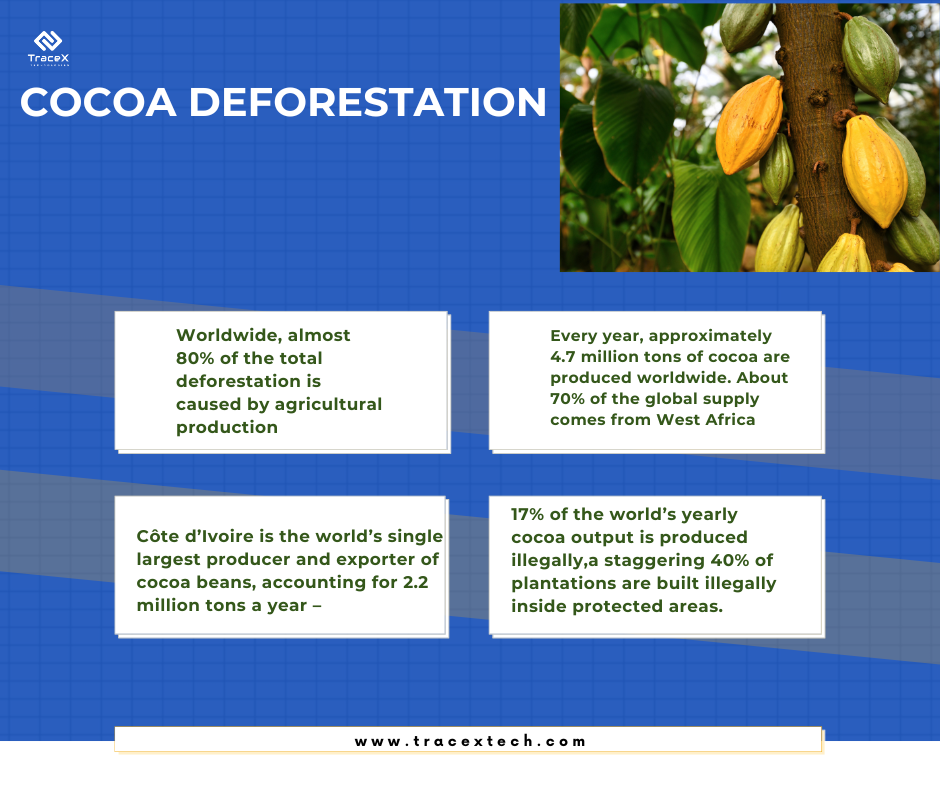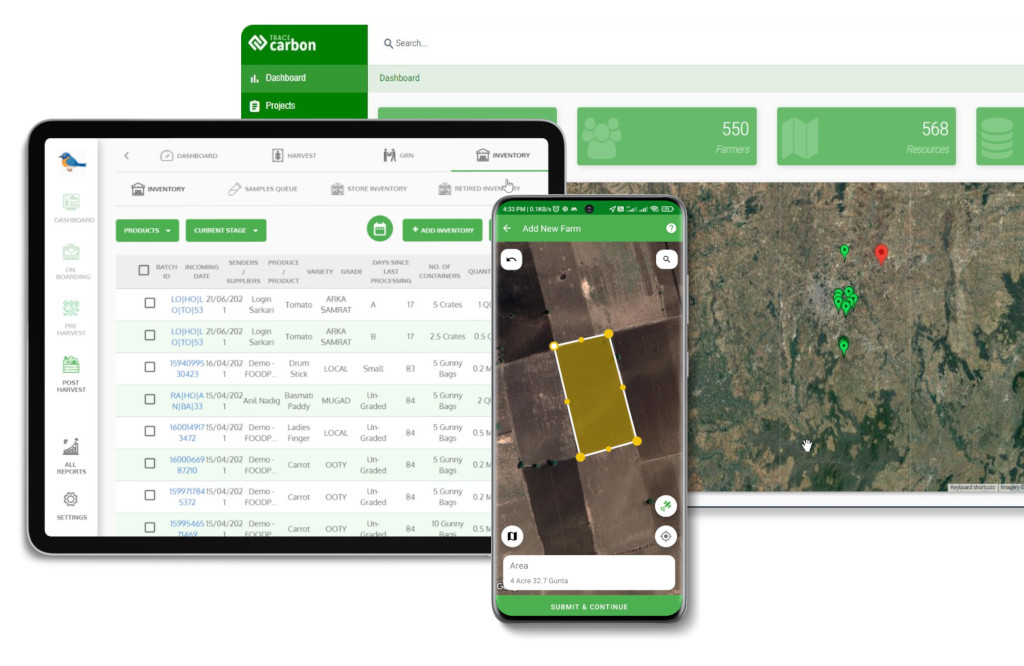Contact: +91 99725 24322 |
Menu
Menu
Quick summary: Discover how the cocoa industry can meet EU Deforestation Regulation (EUDR) standards from bean to bar by implementing sustainable sourcing, blockchain, and satellite monitoring to ensure compliance and forest protection.

Ever wondered what it takes to ensure that the chocolate you love is deforestation-free? It’s no longer just about growing and harvesting, EUDR Cocoa is about ensuring every cocoa bean you source meets strict sustainability standards. For cocoa producers and chocolate manufacturers, the pressure is real. How do you trace each step of the journey from bean to bar while navigating complex supply chains and avoiding costly non-compliance?
Let us break down the challenges of EUDR compliance in the cocoa industry and share practical strategies to make the process smoother. Because compliance doesn’t have to be a headache—you just need the right tools and approach.
Key Takeaways
The EU Deforestation Regulation (EUDR) is one of the most significant changes to hit global supply chains in recent years, and it has profound implications for industries like cocoa. So, what exactly is it, and why does it matter for cocoa producers and manufacturers?
The EUDR is a set of rules introduced by the European Union to curb deforestation and promote sustainability. In simple terms, it requires businesses to prove that the products they’re selling in the EU—like cocoa—are not linked to deforestation or forest degradation. This means that every cocoa bean sourced and processed must be traceable, and companies must demonstrate that it comes from deforestation-free areas.

For cocoa producers and chocolate manufacturers, this is a game-changer. The EU is one of the biggest markets for chocolate, so if you’re in the cocoa business, meeting EUDR standards isn’t just a recommendation—it’s essential. Cocoa is typically grown in tropical regions like West Africa, which are high-risk areas for deforestation. Under the EUDR, you’ll need to provide solid evidence that the cocoa you’re sourcing and selling is grown responsibly, without contributing to deforestation.
The EU Deforestation Regulation (EUDR) is reshaping the global cocoa supply chain—impacting everyone from smallholder farmers to chocolate brands and importers. While the regulation aims to ensure deforestation-free cocoa, it presents unique challenges for each stakeholder involved.
Here’s a look at the key players and the hurdles they face on the path to EUDR compliance:
For thousands of smallholder farmers across West Africa and other cocoa-producing regions, EUDR compliance feels out of reach.
Challenges:
Traders and cooperatives act as the bridge between farmers and exporters but struggle with verification.
Challenges:
Manufacturers source cocoa from complex, fragmented networks—making EUDR compliance a serious operational challenge.
Challenges:
For EU-based importers, the stakes are high—they carry the final compliance liability.
Challenges:
Distributors must ensure compliance continues downstream, with no room for error.
Challenges:
These are the watchdogs—but even they face scale and data challenges.
Challenges:
EUDR compliance isn’t just a farmer or buyer problem—it’s a shared responsibility across the cocoa value chain. Each stakeholder faces unique challenges, but all are connected by the need for accurate traceability, geolocation data, and risk-free documentation.
EUDR compliance isn’t just another box to check. For cocoa farmers, cooperatives, traders, processors, and importers, it’s now a non-negotiable license to operate if you want to keep selling to the lucrative EU market.
If you don’t know exactly where your cocoa is grown, you can’t prove compliance. The EU now requires precise GPS coordinates for every farm supplying cocoa beans.
This helps authorities cross-check farm locations against deforestation-risk zones. If your beans come from farms inside or near protected forests, you risk losing market access.
Many smallholder farmers don’t even have smartphones, let alone GPS maps. Closing this gap is the first big hurdle—and where digital tools become critical.
This is where it gets serious. Under EUDR, it’s not enough to say your cocoa is sustainably sourced—you must prove that no forests were cleared after December 2020 to grow it.
One non-compliant batch could mean your entire container gets rejected at the port—or worse, your company faces fines and reputational damage.
Remote sensing tools and risk assessment models can help monitor farms and flag risks before they become costly.
For many smallholders, formal land titles don’t exist—land is inherited, undocumented, or disputed. But EUDR now requires proof that cocoa is grown legally.
Without these records, entire farming communities may be locked out of the global market. Cooperatives and traders must invest in legal capacity building now.
Gone are the days of bulk mixing cocoa from everywhere. EUDR demands end-to-end traceability—knowing exactly which farm contributed to which shipment.
Cocoa changes hands multiple times—farmers ➔ middlemen ➔ cooperatives ➔ exporters. Every link adds risk of lost data.
A digital system that tags, tracks, and records each batch at every stage is no longer optional—it’s the only way forward.
Finally, every cocoa shipment into the EU needs a Due Diligence Statement (DDS) logged into the EU system.
Get it wrong, and your shipment is held—or worse, rejected. Repeat mistakes? You risk losing your EU buyer permanently.

EUDR is not just paperwork—it’s a supply chain revolution. Cocoa companies that embrace traceability, invest in farmer support, and digitize their processes will win market share, trust, and long-term resilience.
In this new era, the chocolate on store shelves will only be as sustainable as the data behind every cocoa bean.
Manually mapping thousands of smallholder cocoa farms, collecting land ownership papers, and tracking every batch of beans through the supply chain? It’s a nightmare to do on spreadsheets or paper.
That’s where digital traceability and risk assessment platforms step in—not just as a tech upgrade, but as a lifeline for cocoa businesses trying to survive (and thrive) in the EUDR era.
Forget manual record-keeping. Digital platforms automatically track cocoa beans from farm plot to export container, capturing every transaction, movement, and aggregation point.
This creates an unbroken digital chain of custody—exactly what the EU wants. No more scrambling for paper receipts or memory-based sourcing claims.
Traders juggling hundreds of farmers can now trace every bean back to its source with a few clicks—saving time, cost, and reducing errors.
Instead of chasing farmers for land titles or trying to guess boundaries, digital platforms capture accurate GPS coordinates and even allow uploading land ownership documentation.
A verified map of your supply base that proves deforestation-free sourcing—your strongest defense against market bans.
Some platforms integrate satellite imagery to monitor land use changes in near real time—flagging risks before they become compliance disasters.
With every shipment, you need a Due Diligence Statement (DDS)—complete with geolocation, risk assessment, and batch traceability.
Digital platforms auto-generate DDS reports, fully compliant with EUDR formats, ready to be submitted to the EU system.
No more manual paperwork. No more last-minute compliance panic.
Just accurate, audit-ready data—on time, every time.
What if you could spot compliance risks before they derail your shipments?
This isn’t just about avoiding fines—it’s about protecting your brand and securing future supply from verified, responsible sources.
Cocoa companies that digitize now won’t just survive—they’ll unlock premium markets, secure sustainability-linked financing, and future-proof their supply chains.
An EUDR compliance platform is a digital solution designed to help businesses meet the EU Deforestation Regulation (EUDR) requirements. It enables companies to:
The platform streamlines compliance, protects market access, and helps businesses manage complex supply chains with transparency and confidence.
EUDR compliance is not a one-time exercise. It’s the future of how cocoa will be sourced, traded, and consumed globally. Companies that act now won’t just avoid penalties—they’ll gain a competitive edge in markets that increasingly reward traceability, sustainability, and ethical sourcing.
The backbone of EUDR compliance is farm-level geolocation data. If you don’t know exactly where your cocoa is grown, proving deforestation-free sourcing becomes impossible.
EUDR means very little at the farm gate right now. Most smallholders have no idea about the regulation or how it impacts their livelihoods.
Manual tracking, paper records, or basic Excel sheets? Those days are over.
Digital traceability platforms help:
Audits under EUDR will be more complex—involving land legality, deforestation checks, and traceability proofs.
Build partnerships with credible auditors now.
EUDR isn’t about the next shipment—it’s about proving responsible sourcing over time.
Store:
Navigating EUDR compliance for cocoa may seem complex, but it’s an opportunity for the industry to strengthen supply chains, enhance sustainability, and protect forests. By leveraging technology like blockchain and satellite monitoring, building transparent supply chains, and collaborating with stakeholders, cocoa companies can ensure that every bean from farm to chocolate bar meets regulatory requirements. With the right strategies in place, the path toward compliance is also a path toward long-term sustainability.
The EUDR is a regulatory framework aimed at preventing deforestation linked to the production of key commodities, including cocoa. It requires businesses in the EU to ensure that their cocoa products, from beans to finished chocolate bars, are not sourced from deforested areas. This affects cocoa suppliers and manufacturers by necessitating traceability and transparency across the entire supply chain to ensure compliance.
Cocoa companies can comply with EUDR by implementing robust traceability systems to track their cocoa beans from farm to finished product. This involves monitoring the origin of cocoa, verifying that it is grown in areas not linked to deforestation, and maintaining detailed records of each step in the supply chain. Blockchain technology and satellite monitoring can support this by providing accurate, immutable data.
Non-compliance with EUDR can result in significant penalties, including fines, product seizures, and restrictions on market access. Companies found guilty of violating the regulation may face reputational damage and disrupted operations, making it critical for cocoa suppliers and manufacturers to proactively adopt deforestation-free practices and ensure their supply chain meets EU standards.
